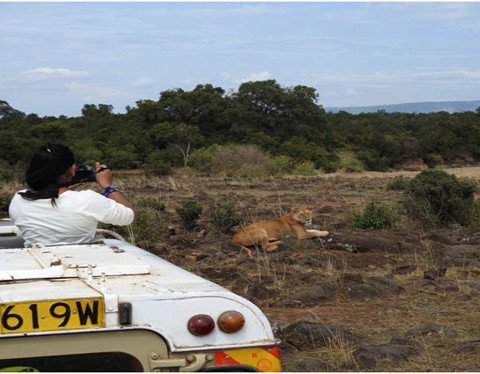Everyone has seen a peacock dance to impress its mate during the breeding season at least once while on a safari. The males have a glistening blue neck and breast with a itnricate wire like crest on their heads. Males also have a long intricate tail that bears ‘ocelli’ (eyes), which they will raise and dsiplay in full splendor during the breeding season, shaking the fanned tail and moving around in a circle to impress a mate. This is the dance of the peacock, the rhythm for which comes from the sounds of the forest, and the steps- choreographed by nature.
The dance is an intricate one with shaking of the tail and undertail coverts interspersed with bending and sometimes a twirling action.
Females however are not as brightly colored as the males and area dull brown color, with slightly greenish blue necks and a crest which is brown. These birds are either seen alone or in small flocks of 2-10 birds with many females and a few males.

A male Peacock on a tree- Mudumalai
The call of the peacock is among the most familiar sounds that can be heard in the forest. The ‘Mee-yoow, Mee-yoow’ can be heard whenever a predator is around or even when the birds are trying to attract a mate, or just advertise their presence. Whatever be the occasion, the peacock never fails to deliver with its flamboyance and elegance, these birds unarguably win over the hearts of most people that visit the forests of Central and Southern India. Most people however do not know that peacocks undergo a period of molt in which the males lose their tail feathers and sport new ones after some time.
The flight of the peacock is quite the sight to behold- with their huge tails sweeping behind them; these birds fly across forest clearings relatively easily. The flapping of their feathers can be heard quite well and this is often a giveaway of their presence overhead.
So, do peacocks know when it will rain? The answer is no. Peacocks like most birds begin their breeding season with the onset of the monsoons, and in South India this is around April when the first showers come in. The birds wouldn’t make excellent weathermen if you asked them when It would rain, but they do know when the monsoon is around the corner.
So, the next time you see a peacock dance, be sure to carry an umbrella and make it a point to watch this lovely performance of theirs.
Author: Joiston Perira – A Naturalist with passion for conserving wildlife and natural habitat, he recently revived the annual bird survey / census at various water bodies / lakes of Bangalore.
0
